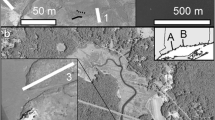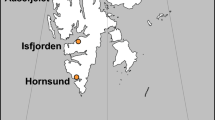Abstract
The burrowing crab,Chasmagnathus granulatus, is the dominant benthic macroinvertebrate of southwest Atlantic salt marshes and tidal flats, having strong ecosystem engineering effects by direct and indirect effects on soil, vegetation, invertebrates, fishes, and birds. Vegetation structure is a main component for bird habitat selection, since greater habitat complexity generates higher niche diversity. This environmental complexity can be modified by species interactions or disturbance events (i.e., by crabs), in turn modifying the associated community. The bird species of salt marshes of the southwest Atlantic are highly dependent on these ecosystems. We assessed the effects of the burrowing crab on the structure of the cordgrass,Spartina densiflora, marshes, and how these changes affected the composition and diversity of birds. This study was conducted at the Mar Chiquita Coastal Lagoon, Argentina (37°40′S, 57°23′W).S. densiflora marshes were classified within three categories: marshes without burrowing crabs, marshes with low burrow densities, and marshes with high burrow densities. We made vegetation and bird surveys during spring beforeS. densiflora produce seeds and in summer when seeds are abundant. We also manipulated inflorescence (i.e., spike) density (a variable affected by crabs) to assess the effect on bird habitat use. The highest inflorescence density ofS. densiflora and highest bird diversity were recorded at low burrow densities. Cover and height ofS. densiflora were negatively correlated with burrow density. The number of bird species and the number of red-capped wren-spinetail,Spartonoica maluroides, were negatively related with cover and height ofS. densiflora. Experiments confirmed that granivorous species used areas with higher spike densities, a variable related to crab burrow density. Burrowing crabs directly and indirectly affect the cover, height, spike density, and morphologic characteristic of seeds ofS. densiflora marshes. These effects indirectly affect the bird community that uses these marshes, being negatively related toS. maluroides and total bird abundance, and positively related to bird diversity.
Similar content being viewed by others
Literature Cited
Adam, P. 1990. Saltmarsh Ecology, Cambridge Studies in Ecology, Cambridge University Press, Cambridge, U.K.
Alkon, P. U. 1999. Microhabitat to landscape impacts: Crested porcupine digs in the Negev Desert highlands.Journal of Arid Environments 41:183–202.
Bibby, C. J., N. D. Burgess, andD. Hill. 1997. Bird Census Techniques. Academic Press, London, U.K.
Bilenca, D. andF. Miñarro. 2004. Identificación de áreas valiosas de pastizales en las pampas y campos Argentinos, Uruguay y sur de Brasil (AVPs). Fundación Vida Silvestre, Buenos Aires, Argentina.
Birdlife. 2004. Threatened Birds of the WorldBirdlife International. Lynx Editions, Barcelona, Spain.
Block, W. M. andL. A. Brennan. 1993. The habitat concept in ornithology: Theory and applications.Current Ornithology 11:35–89.
Bock, C. E. andJ. H. Bock. 1988. Grassland birds in southeastern Arizona: Impacts of fire, grazing and alien vegetation. Technical Publications.International Council of Bird Preservation 7:43–58.
Bortolus, A. 2006. The austral cordgrassSpartina densiflora Brong.: Its taxonomy, biogeography and natural history.Journal of Biogeography 33:158–168.
Bortolus, A. andO. Iribarne. 1999. The effect of the southwestern Atlantic burrowing crabChasmagn athus granulata on aSpartina salt-marsh.Marine Ecology Progress Series 178:79–88.
Bortolus, A., P. Laterra, andO. Iribarne. 2004. Crab-mediated phenotypic changes inSpartina densiflora Brong.Estuarine Coastal and Shelf Science 59:97–107.
Boschi, E. E. 1964. Los crustáceos decápodos Brachyura del litoral Bonaerense (R. Argentina). Boletín del Instituto de Biología Marina.Mar del Plata 6:1–99.
Botto, F. andO. Iribarne. 1999. The effect of the burrowing crabchasmagnathus granulata on the benthic community of a SW Atlantic coastal lagoon.Journal of Experimental Marine Biology and Ecology 241:263–284.
Botto, F., O. Iribarne, J. Gutiérrez, J. Bava, andA. Gagliardini. 2006. The ecological importance of passive deposition of meiofauna and organic matter into burrows of the SW Atlantic burrowing crabChasmagnathus granulatus.Marine Ecology Progress Series 312:201–210.
Botto, F., G. Palomo, O. Iribarne, andM. Martinez. 2000. The effect of the Southwestern Atlantic burrowing crabChasmagnathus granulata on habitat use and foraging activity of migratory shorebirds.Estuaries 23:208–215.
Botto, F., I. Valiela, O. Iribarne, P. Martinetto, andJ. Alberti. 2005. Impact of burrowing crabs on C and N sources, control, and transformations in sediments and food webs of SW Atlantic estuaries.Marine Ecology Progress Series 293:155–164.
Canevari, M., P. Canevari, G. R. Carrizo, G. Harris, J. Rodríguez Mata, andR. J. Straneck. 1991. Nueva guía de las aves argentinas Volume 2. Fundación Acindar, Buenos Aires, Argentina.
Chapman, V. J. 1960. Saltmarshes and Salt Deserts of the World. Plant Science Monographs. Interscience Publishers, Inc., New York, and Leonard Hill Limited, London.
Comparatore, V. M., M. M. Martínez, A. I. Vasallo, M. Barg, andJ. P. Isacch. 1996. Abundancia y relaciones con el hábitat de aves y mamíferos en pastizales dePaspalum quadrifariun (Paja Colorada) manejados con fuego (Prov. de Buenos Aires, Argentina).Interciencia 21:228–237.
Connell, J. H. 1978. Diversity in tropical rain forest and coral reefs.Science 199:1302–1310.
Conner, R. N. andJ. G. Dickson. 1980. Strip transect sampling and analysis for avian habitat studies.Wildlife Society Bulletin 8:4–10.
Escapa, M., O. O. Iribarne, andD. Navarro. 2004. Effects of the intertidal burrowing crabChasmagnathus granulatus on infaunal zonation patterns, tidal behavior, and risk of mortality.Estuaries 27:120–131.
Fanjul, M. E., A. Grela, and O. Iribarne. In Press. Effects of the dominant SW Atlantic intertidal burrowing crabChasmagnathus granulatus on sediment chemistry and nutrient distribution.Marine Ecology Progress Series.
Ferns, P. N. 1992. Bird Life of Coasts and Estuaries. Cambridge University Press, Cambridge, U.K.
Fox, J. F. 1979. Intermediate disturbance hypothesis.Science 204: 1344–1345.
Fretwell, S. D. andH. Lucas. 1970. On territorial behavior and other factors influencing habitat distribution in birds.Acta Biotheoretica 19:16–52.
Gilham, M. E. 1960. Destruction of indigenous heath vegetation in Victorian seabird colonies.Australian Journal of Botany 8:277–294.
Gutiérrez, J., C. G. Jones, P. M. Groffman, S. E. G. Findlay, O. O. Iribarne, P. D. Ribeiro, andC. M. Bruschetti. 2006. The contribution of crab burrows excavation to carbon availability in surficial salt-marsh sediments.Ecosystems 9:1–13.
Helzer, C. J. andD. E. Jelinsky. 1999. The relative importance of patch area and perimeter-area ratio to grassland breeding birds.Ecological Applications 9:1448–1458.
Herkert, J. R. 1994. The effects of habitat fragmentation on midwestern grassland bird communities.Ecological Applications 4:461–471.
Hildén, O. 1965. Habitat selection in birds. A review.Annales Zoologici Fennici 2:53–75.
Hughes, R. G. 2004. Climate change and loss of saltmarshes: Consequence for birds.Ibis 146:21–28.
Iribarne, O., A. Bortolus, andF. Botto. 1997. Between-habitats differences in burrow characteristics and trophic modes in the southwestern Atlantic burrowing crabChasmagnathus granulata.Marine Ecology Progress Series 155:132–145.
Iribarne, O., F. Botto, P. Martinetto, andJ. Gutiérrez. 2000. The role of the SW Atlantic burrowing crab in sequestering debris.Marine Pollution Bulletin 40:1057–1062.
Iribarne, O., M. Bruschetti, M. Escapa, J. Bava, F. Botto, J. Gutiérrez, G. Palomo, K. Delhey, P. Petracci, andA. Gagliardini. 2005. Small and large-scale effect of the SW Atlantic burrowing crabChasmagnathus granulatus on habitat use by migratory shorebirds.Journal of Experimental Marine Biology and Ecology 315:87–101.
Iribarne, O., P. Martinetto, E. Schwindt, F. Botto, A. Bortolus, andP. García Borboroglu. 2003. Evidences of habitat displacement between two common soft-bottom SW Atlantic intertidal crabs.Journal of Experimental Marine Biology and Ecology 296:167–182.
Isacch, J. P., C. S. B. Costa, L. Rodríguez-Gallego, D. Conde, M. Escapa, D. A. Gagliardini, andO. O. Iribarne. 2006. Association between distribution pattern of plant communities and environmental factors in SW Atlantic saltmarshes.Journal of Biogeography 33:888–902.
Isacch, J. P., S. Holz, L. Ricci, andM. Martínez. 2004. Post-fire vegetation change and bird use of a salt marsh in coastal Argentina.Wetlands 24:235–243.
Isacch, J. P., N. O. Maceira, M. S. Bo, M. R. Demaría, andS. Peluc. 2005. Bird-habitat relationship in semiarid natural grasslands and exotic pastures in the west pampas of Argentina.Journal of Arid Environment 62:267–283.
Isacch, J. P. andM. Martínez. 2001. Estacionalidad y relaciones con la estructura del hábitat de la comunidad de aves de pastizales de paja colorada (Paspalum quadrifarium) manejados con fuego en la Provincia de Buenos Aires, Argentina.Ornitología Neotropical 12:345–354.
Jobin, B., J. L. Desgranges, andC. Boutin. 1996. Population trends in selected species of farmland birds in relation to recent developments in agriculture in the St. Lawrence Valley.Agriculture, Ecosystems and Environment 57:103–116.
Jones, C. G., J. Lawton, andM. Shachak. 1994. Organisms as ecosystem engineers.Oikos 69:373–386.
Jones, C. G., J. Lawton, andM. Shachak. 1997. Positive and negative effects of organisms as physical engineers.Ecology 78: 1946–1957.
MacArthur, R. H. andJ. W. MacArthur. 1961. On bird species diversity.Ecology 42:594–598.
Magurran, A. E. 1998. Ecological Diversity and its Measurement. Princeton University Press, Princeton, New Jersey.
Marone, L. 1991. Habitat features affecting bird spatial distribution in the Monte Desert, Argentina.Ecología Austral 1:77–86.
Martinetto, P., O. Iribarne, andG. Palomo. 2005. Effect of fish predation on intertidal benthic fauna is modified by crab bioturbations.Journal of Experimental Marine Biology and Ecology 318:71–84.
Martinez, M. M. 2001. Avifauna de Mar Chiquita, p. 227–247.In O. Iribarne (ed.), Reserva de Biosfera Mar Chiquita. Editorial Martín, Mar del Plata, Argentina.
Martínez, M. M., M. S. Bó, andJ. P. Isacch. 1997. Hábitat y abundancia de Porzana spiloptera y Coturnicops notata en Mar Chiquita, Prov. de Buenos Aires, Argentina.Hornero 14:274–277.
Reta, R., P. Martos, G. M. E. Perillo, M. C. Piccolo, andA. Ferrante. 2001. Características hidrográficas del estuario de la Laguna de Mar Chiquita, p. 31–52.In O. Iribarne (ed.), Reserva de Biosfera Mar Chiquita. Editorial Martín, Mar del Plata, Argentina.
Roth, R. R. 1976. Spatial heterogeneity and bird species diversity.Ecology 57:773–782.
Roxburgh, S. H., K. Shea, andJ. B. Wilson. 2004. The intermediate disturbance hypothesis: Patch dynamics and mechanisms of species coexistence.Ecology 85:359–371.
Spivak, E., K. Anger, T. Luppi, C. Bas, andD. Ismael. 1994. Distribution and habitat preferences of two grapsid crab species in Mar Chiquita lagoon (Province of Buenos Aires, Argentina).Helgoländer Meeresuntersuchungen 48:59–78.
Steele, B. B. 1993. Selection of foraging and nesting sites by Black-throated blue Warblers—their relative influence on habitat choice.Condor 95:568–579.
Vickery, P. D., M. L. Hunter, andS. M. Melvin. 1994. Effects of habitat area on the distribution of grassland birds in Maine.Conservation Biology 8:1087–1097.
Wiens, J. A. 1973. Pattern and process in grassland bird communities.Ecological Monographs 43:237–270.
Wilson, M. F. 1974. Avian community organization and habitat structure.Ecology 55:1017–1029.
Zar, J. H. 1999. Biostatistical Analysis. Prentice-Hall, Inc., Engle-wood Cliff, New Jersey.
Author information
Authors and Affiliations
Corresponding author
Rights and permissions
About this article
Cite this article
Cardoni, D.A., Isacch, J.P. & Iribarne, O.O. Indirect effects of the intertidal burrowing crabChasmagnathus granulatus in the habitat use of Argentina’s South West Atlantic salt marsh birds. Estuaries and Coasts: J ERF 30, 382–389 (2007). https://doi.org/10.1007/BF02819385
Received:
Revised:
Accepted:
Issue Date:
DOI: https://doi.org/10.1007/BF02819385




